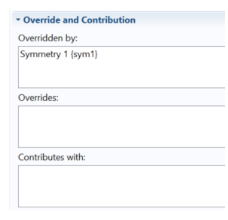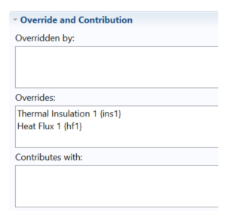Many boundary conditions are available in heat transfer. Some of these can coexist (for example, Heat Flux and Thin Layer); others cannot (for example, Heat Flux and Thermal Insulation).
Several categories of boundary condition exist in heat transfer. Table 14-3 gives the overriding rules for these groups.
When there is a boundary condition A above a boundary condition B in the model tree and both conditions apply to the same boundary, use Table 14-3 to determine if A is overridden by B or not:
|
•
|
Locate the line that corresponds to the A group (see above the definition of the groups). In the table above only the first member of the group is displayed.
|
|
•
|
Consider a boundary where Temperature is applied. Then a Diffuse Surface boundary condition is applied on the same boundary afterward.
|
•
|
Temperature belongs to group 1.
|
|
•
|
Diffuse Surface belongs to group 5.
|
The cell on the line of group 1 and the column of group 5 is empty so Temperature and Diffuse Surface contribute.
Consider a boundary where Heat Flux is applied. Then a Symmetry boundary condition is applied on the same boundary afterward.
|
•
|
Heat Flux belongs to group 3.
|
|
•
|
Symmetry belongs to group 2.
|
|
•
|
The cell on the line of group 3 and the column of group 2 contains an X so Heat Flux is overridden by Symmetry.
|
This mechanism can be checked on the COMSOL Desktop, in the Override and Contribution section of each feature, as shown in the following table:

